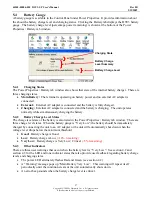
44208-00006-000 DSV3-SP User’s Manual
Rev 0B
2/12/2009
31
Copyright © 2009 by Datastrip, Inc. All rights reserved.
Reproduction in whole or in part is prohibited.
11.2.3
Disconnect
•
Disconnecting the ActiveSync cable or removing the DSV3 terminal from the docking cradle will
disconnect the session on the PC side, but not on the DSV3. Manually disconnect the DSV3 by
clicking on the ActiveSync icon in the system tray and clicking “Disconnect” or do nothing and
the session will timeout after one minute. Both ends of the connection must be disconnected
before you can reconnect the cable and start another ActiveSync session.
11.2.4
Troubleshooting the Connection
If a connection is not automatically established, check the following:
•
The DSV3 will not connect while it is in Suspend mode. Wake the DSV3 from Suspend prior to
placing it in the docking station.
•
Verify that “Serial via COM1” is selected on your terminal. Go to the Control Panel and double
click “PC Connection”. On this screen, you should see “Serial via COM1”. If not, then click
“Change Connection”. Click the scroll bar arrow. Select “Serial via COM1” and click “OK”.
Click “OK” again to close the PC Connection screen. Re-insert your DSV3 into the docking cradle
to get connected.
•
Place the DSV3 in the docking cradle. On the PC, open the ActiveSync application and select
“File/Connection Settings”. Then select “Connect”. This will initiate a connection with the DSV3
from the PC side.
12
Docking Station
The docking station is an optional peripheral available for the DSV3
mobile terminal, and it has the following attributes:
•
Wired I/O Access:
Provides convenient access to the wired I/O
ports on the mobile terminal when docked.
USB 2.0 Host: standard A (x2)
USB 2.0 Client: standard B (x1)
Ethernet: 10/100 RJ45 (x1)
RS-232 DB9 (x1)
•
Battery Charging:
Supplies power to charge the batteries
inside the mobile terminal
•
Storage:
Provides a convenient place to store the mobile
terminal with “grab and go” access.
The docking station mates with the DSV3 terminal via a high
density connector located on the bottom of the terminal. There are
two guide holes on the terminal (and corresponding guide posts on
the docking station) that make it easy to dock and remove the
mobile terminal while providing robust and rugged connectivity.
Guide Holes
High Density Connector
for Docking Station



















